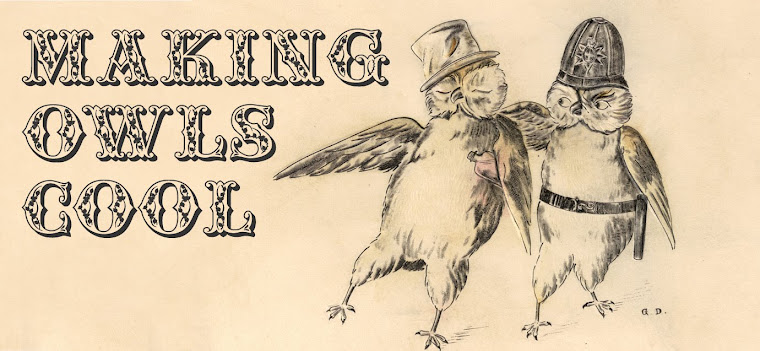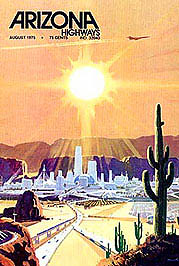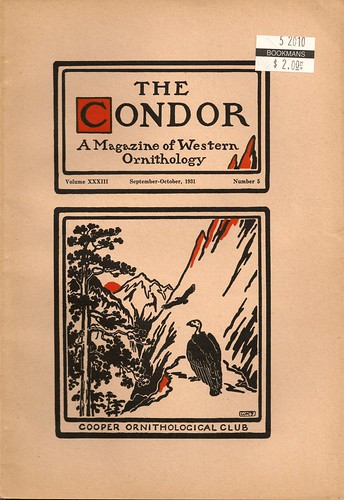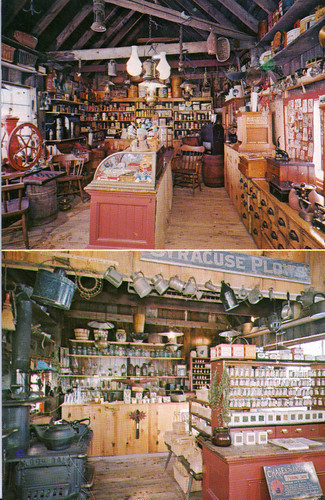I haven't been posting very much lately because we're preparing to move. Unfortunately, we're moving from Tucson to Glendale, a suburb of Phoenix. People in the Valley of Sun often deride Tucson for being dirty, stinky, ill-kept, but we prefer the character of Tucson to the industrial/ residential complex of the Phoenix area. We found another cool house near historic downtown Glendale, which is a very pretty and homey part of town (even if it's 3 parts CA to 1 part AZ...) and we'll be ex-Worcesterite, ex-Tucsons soon. We're trying to have a good attitude about the move. Still, even though we're moving to someplace that's actually hotter, it feels like we're leaving the desert for a very, very hot Anywhere, USA. The Phoenix area has lots of imports - green grass, more palms than cactus, lots of citrus trees. Nearly all residential areas are part of pre-designed housing developments or subdivisions. Not a lot of desert left. And we're leaving our beautiful view of the Santa Catalina Mountains, along with a lot of friends (though, unlike mountains, friends can visit and use the phone...).
On the positive side, this move brings us closer to all points north. Flagstaff, Sedona, the Mogollon Rim, the White Mountains and more. And, if you've followed the blog at all, you'll know I'm a pretty big fan of the Superstition Mountains, which we'll be much closer too. The Mazatal Wilderness is huge and close, too, as is a nice hike up to the Phoenix-area sky island, Four Peaks. I can't see any of these mountains my new house in Glendale, but I know they're there, and that's pretty good.
So I'm signing off until next week sometime. Off to work.
Tuesday, June 22, 2010
Tuesday, June 15, 2010
The Condor: A Magazine of Western Ornithology
"The Condor" began in 1899 as "The Bulletin of the Cooper Ornithological Club" and changed the name to "The Condor" in 1900. For years the journal was dedicated to studying birds of western North America. This is issue is from 1931. I found it at Bookmans here in Tucson, AZ; there are many more there, and, at only $2 an issue, I think I'll try to find an older one next time. I grabbed this one because it has models of homemade hummingbird feeders.

The Condor is still around today, but it's changed a bit. The scope has expanded beyond the North America and it's now a peer-reviewed academic journal; it's edited by Michael A. Patten, who's a professor in the Oklahoma Biological Survey at the University of Oklahoma, amongst other things. The Cooper Ornithological Club has become the Cooper Ornithological Society.
Since its inception, The Condor has promoted bird conservation. Considering the environmental changes and urban sprawl throughout the West over the last 111 years, I'm sure Chester Barlow and the original writers had more birds to see than we do now in habitats that no longer exist. It got me thinking about what's been lost and what was never discovered. We tend to think of science as absolute, plodding, and, in some ways, interminable. We learn new things all the time. Yet, we're destroying things all the time, so we must be destroying things before we know about them at all, let alone understand them scientifically. Older scientific publications, like back issues of The Condor, seem dated. "We've come a long way since then" is a scientific truism. But eighteenth, nineteenth, and early twentieth century naturalists were looking at things that no longer exist, things we have no way to observe now, and I wonder when a field of study will emerge dedicated solely to reevaluating former research. It's terrifying to envision this as the future of ornithology, zoology, or naturalism...

The Condor is still around today, but it's changed a bit. The scope has expanded beyond the North America and it's now a peer-reviewed academic journal; it's edited by Michael A. Patten, who's a professor in the Oklahoma Biological Survey at the University of Oklahoma, amongst other things. The Cooper Ornithological Club has become the Cooper Ornithological Society.
Since its inception, The Condor has promoted bird conservation. Considering the environmental changes and urban sprawl throughout the West over the last 111 years, I'm sure Chester Barlow and the original writers had more birds to see than we do now in habitats that no longer exist. It got me thinking about what's been lost and what was never discovered. We tend to think of science as absolute, plodding, and, in some ways, interminable. We learn new things all the time. Yet, we're destroying things all the time, so we must be destroying things before we know about them at all, let alone understand them scientifically. Older scientific publications, like back issues of The Condor, seem dated. "We've come a long way since then" is a scientific truism. But eighteenth, nineteenth, and early twentieth century naturalists were looking at things that no longer exist, things we have no way to observe now, and I wonder when a field of study will emerge dedicated solely to reevaluating former research. It's terrifying to envision this as the future of ornithology, zoology, or naturalism...
Sunday, June 13, 2010
Second Saturdays
One of the few things Erin and I enjoyed about living in Tempe more than Tucson was First Fridays. The first Friday of each month, the streets around Roosevelt and 7th in Phoenix are shut down, bars and art galleries are open, vendors and performers take to the street and it's a really, really great time. I particularly love it at night during the summer when it's still hot, but comfortable.
Then we learned about Second Saturdays, Tucson's version of the same event. We went last night and it was pretty good. Fewer vendors and art galleries than First Fridays, but I think it's fairly new and just catching on. It's on Congress Street, so it's right in downtown Tucson. A lot of people were out and I have no doubt it will eventually come into it's own and be just as great as First Fridays. The big difference now is that they shut down the streets in Phoenix, but not in Tucson. It would be a lot, lot better if they shut down Congress Street during the event.
The band above is The Mission Creeps, a cool Tucson band we discovered while watching our favorite Phoenix band, The Love Me Nots.
Wednesday, June 9, 2010
Falafel Chips
Erin and I were down at the Food Conspiracy co-op on 4th Ave earlier and stumbled upon something awesome - Falafel Chips. They are exactly what you'd expect, which is, of course, chips that taste like falafel, but they're also organic and not too bad for you. They're sort of the consistency of Tostito Rounds. The maker, Flamous Brands, advertises these as the first chips made specifically for hummus dip. While the people who make pita chips might disagree, they would have a hard time arguing that anything is as tasty with hummus as Falafel Chips. The Falafel Chips website has some tasty looking recipes, but, if I might plug a local Arizona company, Dr. Hummus hummus would be really, really good on these. Dr. Hummus's rosemary pita chips might be the only hummus-to-mouth vehicle that could potentially rival Falafel Chips. I'm making myself pretty hungry here...
Tuesday, June 8, 2010
Homesick Yankee Ramblings Part 4 - Antiques and Country Stores
From reverse: "Black Lantern Antiques and Country Store Museum - Mohawk Trail - Charlemont, Mass 01339. Early Country Store Items. A nostalgic trip to the past. Old time favorites for all. Nina Noga, Curator"
Ok, I know that there are antique stores in Arizona, but for the most part, they sell things you get at flea markets in Massachusetts. The Arizonan version of the flea market, the swap meet, sells mostly fake Ed Hardy crap and lame cell phone covers. Therefore, I miss New England antique shops and country stores. To make matters worse, my brother visits them frequently and posts pictures of all the great stuff he finds on Flickr.
Country stores in the Northeast always smell like scented candles. They sell cool things like breadmaking kits in Ball jars, sticks of honey, and different kinds of fudge. I'm also a sucker for magnets, though country-theme cow flags aren't really my thing.
As for antique stores, every one is a museum filled with great stuff you can take home. New England antique stores have a lot of artifacts from the nineteenth and early twentieth century with the occasional older find thrown in. I tend to want to buy animal themed stuff or naturalist artifacts, though Erin uses her veto power to prevent taxidermy purchases. It's really fascinating to see what things have the power to move from consumer items to artifacts and how the objects shift roles when they move from the retail store to the antique shop. To become an "Antique" is probably like Heaven in object afterlife, while becoming "garbage" is Hell. After a hard life as a work object, the antique is retired, placed in a safe location and meticulously maintained. If objects commit mortal sins, like breaking or becoming obsolete too quickly, they're discarded, crushed, recycled, buried.
As I look around my house and wonder at how some of the old things I have made the transition, I also look at many of my new things and wonder what the future holds for them. The silver lining of this way of thinking is that it make me want to take care of my stuff; the toxic lining is that it predisposes me to being a hoarder.
Ok, I know that there are antique stores in Arizona, but for the most part, they sell things you get at flea markets in Massachusetts. The Arizonan version of the flea market, the swap meet, sells mostly fake Ed Hardy crap and lame cell phone covers. Therefore, I miss New England antique shops and country stores. To make matters worse, my brother visits them frequently and posts pictures of all the great stuff he finds on Flickr.
Country stores in the Northeast always smell like scented candles. They sell cool things like breadmaking kits in Ball jars, sticks of honey, and different kinds of fudge. I'm also a sucker for magnets, though country-theme cow flags aren't really my thing.
As for antique stores, every one is a museum filled with great stuff you can take home. New England antique stores have a lot of artifacts from the nineteenth and early twentieth century with the occasional older find thrown in. I tend to want to buy animal themed stuff or naturalist artifacts, though Erin uses her veto power to prevent taxidermy purchases. It's really fascinating to see what things have the power to move from consumer items to artifacts and how the objects shift roles when they move from the retail store to the antique shop. To become an "Antique" is probably like Heaven in object afterlife, while becoming "garbage" is Hell. After a hard life as a work object, the antique is retired, placed in a safe location and meticulously maintained. If objects commit mortal sins, like breaking or becoming obsolete too quickly, they're discarded, crushed, recycled, buried.
As I look around my house and wonder at how some of the old things I have made the transition, I also look at many of my new things and wonder what the future holds for them. The silver lining of this way of thinking is that it make me want to take care of my stuff; the toxic lining is that it predisposes me to being a hoarder.
Saturday, June 5, 2010
Arizona by the Numbers
I found this graph online - Tumblr, actually - and it links back to an interesting article in the Atlantic, based on a blog post by Rob Pitingolo entitled Where the Smart People Live. It's an electronic nomad, I suppose. I guess Pitingolo's idea is that the density of educated people in a given place effects the nature of the place. We usually look at these sorts of statistics in terms of percentage, which I think pays more attention to population density. For example, Phoenix only has 2,782 people per square mile, vs, New York City, which has 26,402 people per square mile. So while it looks like a lot more people are educated in NYC, NYC has 27.4% with a bachelors, while Phoenix is 22.4%. Riverside looks like it has more educated people than Phoenix in this graph, but only 19.1% have bachelors or higher and Miami, which looks high up on the scale, is only 16.2%. What Pitingolo suggests is that our traditional ways of looking at the educational makeup of a community is flawed because there is no guarantee that educated people in a give location interact and looking at density may be more accurate.
I would like to explore Arizona more closely on this model and try to draw some general, and perhaps anecdotal conclusions. Tucson and Phoenix have nearly identical population densities and % of educated people.
Phoenix - 2,782 people/square mile and 22.4% of people with bachelors or higher.
Tucson - 2,500 people/square mile and 22.9% of people with a bachelors or higher.
So Phoenix has 470 people with bachelors or higher/square mile vs Tucson's 573. A hundred more people with college degrees in a square mile might make a difference in the make up of the community, but they're still very close. Also, the real makeup of each city would put more people with degrees close to the big universities, not evenly distribute them throughout. Arizona State University, the main university in the Phoenix area, has its largest campus in Tempe, AZ, not Phoenix, while Tucson has all of the University of Arizona. Tempe has a 39.6% of the population with bachelors or higher and 3959.7 people/square mile, meaning there are 1568 people with bachelors or higher/square mile. Tempe is really geographically close to Phoenix - a visitor could travel between the two cities and probably not even notice. Many people live in one and work in the other. Pitingolo does also look at counties, presumably for this reason. Scottsdale has a whopping 44.1% of the population with bachelors or higher - 1% less than San Francisco, which tops Pitingolo's city chart. Indeed, Scottsdale and Tempe are arguably two of the well-off cities in Arizona. Other cities, like Mesa and Peoria, have population densities and % educated closer to Phoenix or Tucson.
So, in Pitingolo's model, Tucson should be more similar to Phoenix or Mesa or Peoria than Tempe, but, ideologically at least, it's not. Tucson, like Tempe, is more liberal - it has primarily democrats as representatives and lots of weird artsy, hippy, New Age stuff. Certainly, Phoenix has it's cool downtown area, around Roosevelt and 7th, but it's not like Tucson. Even more surprising is how different Tucson is in nature from cities like Mesa or Peoria, both of which are conservative strongholds, though they have similar statistics to Tucson. Perhaps the presence of ASU and U or A do something to make Tucson and Tempe more ideologically similar, but anyone who has been to both places would think they felt pretty different. To complicate things further, Scottsdale is probably the most affluent major city in Arizona and certainly the most educated, but it is also more conservative than Tempe or Tucson. So level of education, at least in Arizona, doesn't appear to correlate to how liberal or conservative a place is. Economically, Tucson is worse off than most of the cities in Maricopa County, including Phoenix, Tempe, and Mesa.
So what does Pitingolo's idea of education density tell us about a city? Well, just like the usual percentage model, it just gives us some numbers. Cities are places with identities that are also traditional, cultural, ideological, economic, and intellectual. Trying to make assertions about how best to measure the impact of educated people on a city must be done holistically. Boston and San Francisco's educated populations result from the culture of those places as much as the culture of those place result from the educated populations. And as far as this New Englander is concerned, Tucson is the best city in Arizona, regardless of what the numbers say.
Friday, June 4, 2010
Hexalectris revoluta/colemanii
A rare orchid named Hexalectris colemanii is delaying Rosemont Copper's plans to open a mine near the Santa Rita Mountains south of Tucson. The flower is extremely rare and requires exact conditions, including a type of fungi, to grow. The orchid also grows in parts of Mexico, New Mexico, and Texas. Outside of Arizona, it's called Hexalectris revoluta, but the Arizona variety may be a unique species and it's named Hexalectris colemanii after Tucson orchid expert, Ronald Coleman. The Forest Service is delaying a report on the environmental impacts of the mine in order to study the impact of the mine on this unique flower.
Of course, the idiots are raising the usual sound and fury. The AZ Daily Star quotes Benson, AZ mayor Mark Fenn as saying, "They will use every excuse to delay things. It is beyond me why they would hinder a potential economic resource for the region, given the high rate of unemployment we are experiencing right now." At least Mr. Fenn is honest - clearly the implications of conservation and environmental protect are indeed "beyond him." Obviously, we should disregard the future of our local environment because of events that are happening "right now." There's short sighted...and then there's this guy. I wish people in Arizona would find leaders who don't find really, really simple stuff "beyond" them.
Of course, the idiots are raising the usual sound and fury. The AZ Daily Star quotes Benson, AZ mayor Mark Fenn as saying, "They will use every excuse to delay things. It is beyond me why they would hinder a potential economic resource for the region, given the high rate of unemployment we are experiencing right now." At least Mr. Fenn is honest - clearly the implications of conservation and environmental protect are indeed "beyond him." Obviously, we should disregard the future of our local environment because of events that are happening "right now." There's short sighted...and then there's this guy. I wish people in Arizona would find leaders who don't find really, really simple stuff "beyond" them.
Thursday, June 3, 2010
Javelina Homicide
A few months back, a new law passed allowing loaded guns in National Parks. The powers that be felt that appeasing the monomaniacal guntards was worth the risks. What could go wrong? Well, this week two dead javelina were found in Saguaro National Park here in Tucson. One had been shot in the head, the other was too eaten by scavengers to determine the cause of death, but they were found together, so it seems likely that they were both shot. The Arizona Fish and Game Department is offering up to a $1000 reward for information leading to the arrest of the javelina killer. If you know anything about the killing, contact Arizona Game and Fish wildlife manager Diane Tilton at 310-7559 or Operation Game Thief at 1-800-352-0700.
Javelina are peccaries, not pigs, and they are related to other species of South and Central American peccaries. They are also known as collared peccaries. They are fairly common in Arizona and they can be a nuisance. Though they rarely attack people, they sometimes like to eat garbage and dog food and most people know someone who has had javelina in their yard. Javelina are a unique native species, not destructive or feral like wild pigs.
People do legally hunt javelina throughout the Southwest. We non-hunters know that hunting is a tradition and, sometimes, a necessary means of population control, so it's not that the javelina were shot that is terrible; it's that they were shot in a National Park and just left there. The javelina are a part of Saguaro National Park, just like the trees, mountains, cacti, and rocks. We don't need armed people killing wildlife in our national parks. We don't need guns in our national parks. If Teddy Roosevelt could abstain from killing animals on his tour of Yellowstone, then what more precedent do we need? We need legislation to get the guns out of the parks. But first, let's hope the loser who shot these two animals gets caught.
Javelina are peccaries, not pigs, and they are related to other species of South and Central American peccaries. They are also known as collared peccaries. They are fairly common in Arizona and they can be a nuisance. Though they rarely attack people, they sometimes like to eat garbage and dog food and most people know someone who has had javelina in their yard. Javelina are a unique native species, not destructive or feral like wild pigs.
People do legally hunt javelina throughout the Southwest. We non-hunters know that hunting is a tradition and, sometimes, a necessary means of population control, so it's not that the javelina were shot that is terrible; it's that they were shot in a National Park and just left there. The javelina are a part of Saguaro National Park, just like the trees, mountains, cacti, and rocks. We don't need armed people killing wildlife in our national parks. We don't need guns in our national parks. If Teddy Roosevelt could abstain from killing animals on his tour of Yellowstone, then what more precedent do we need? We need legislation to get the guns out of the parks. But first, let's hope the loser who shot these two animals gets caught.
Subscribe to:
Posts (Atom)






